History
In 1919, a group of men from Ballybofey, Co Donegal, set off for Scotland with a mission.
For Timothy Meehan, Henry McNulty, Hugh Magee, James Durnin, Wiliam McHugh, James Magee,Patrick McNulty, and James T. O’Murphy, 1919 was the year in which they would build a parish hall in Ballybofey, for the "recreation, entertainment, and education of the people of Ballybofey and district.". The money they raised by sending a collection team to Scotland would begin the building of the Isaac Butt Hall.
It was at first a small building, just over 1200 square feet, and the size of a decent modern bungalow.
But it would become the social and cultural heart of the Finn Valley, and even the county at large, for the next eight decades. And it would indirectly usher in some of the most profound and positive changes ever experienced in Donegal.
Those men, and their colleagues at home, formed the original Butt Hall Committee.
The 1920s
From the beginning, the Isaac Butt Hall was a popular destination with the traveling shows, the Carrickfords, the Daniels, the Dobells and others. These were traveling drama and entertainment groups who roamed the country circus-fashion, putting on plays and shows wherever they could. More consistent entertainment came, as expected, from the local drama group, in particular from Master Timoney’s "Fun of the Fair," in 1928.
The 1930s
Dances, the other great magnet associated with the Butt, came more to the fore in this decade. But they were still monthly events at best.
Following the first of many extensions, billiards and cards became regular pastimes. Whist, Twenty-five, and especially poker, "the big school and the wee school," passed the pre-television evenings and weekends.
There are also fond memories of the tennis courts behind the Butt, and the impromptu dances, which often followed tennis matches.
The 1940s
The decade began with a building which was run-down, neglected and usually empty, and ended with the physical, social and financial expansion which would place the Isaac Butt hall at the heart of the community.
New blood arrived on the Committee itself, and the much larger Dance Committee was formed. The "Supper Dances" became frequent, encouraged by the brand-new maple floor, laid down as soon as wartime shortages ended. The floor was part of a decade-long round of extensions and refurbishments, which began in 1948.
The 1950s
Everything, absolutely everything, would take place in the Butt for the next forty years. No matter whether you wanted to listen to a concert, donate a pint of blood, borrow a library book, join the opera society or organise a bazaar or a sale of work, the Butt was where you went.
This was the era when the Butt really began to make money, and the Committee began to plan on improving the infrastructure and employment prospects of the town itself. (An early project was street lighting.) It was also the era when the Golf Club pioneered the concept of raising finance by renting the Hall to run dances and bingo.
It was the era when the Butt Hall players, forerunners of the Balor theatre, reorganised themselves and began to win competitions at national level.
Above all, it was the era when the showband scene began.
The 1960s
Ireland had its very own Sixties in the form of the Showbands. Highly skilled bands of eight or nine members, including brass, toured the country in their hundreds, creating a glittering, colourful nightlife the like of which Ireland had never seen before.
The Butt Hall hosted them all. No drink, no social problems, just hundreds and even thousands of young people, dancing the night away, enjoying themselves, and more often than not meeting their life partner. Busloads of dancers trekked in nightly from all over the county and from Northern Ireland.
During one of those dances, a potentially disastrous flood trapped hundreds of patrons in the venue overnight.
The Committee, almost by accident, acquired tracts of development land, and managed to attract some industry to the town by offering free sites and other support. It was also ready to step into the breach when free education arrived, supplying a site and temporary accommodation for the new St Columba’s.
The 1970s
The good work continued in the 1970’s. All the big names played the Butt – Sandie Shaw, Brendan Bowyer, the Glitter Band, Dickie Rock, and, most memorably, the Celtic-rock maestros, Horslips.
The Butt Hall Players continued their winning ways, rising to All-Ireland success. Local bodies continued to finance themselves through the Butt, renting the hall for a reasonable fee and running bazaars, concerts, dances and card drives. And the vast repertoire of activities, from dancing competitions to school drama festivals, continued unabated.
The winds of change also began to blow. Relaxed drinking laws drew many meetings, and even more dances, to the warmer and more comfortable pubs and hotels.
The 1980s
Despite the ever-increasing number of alternative attractions, the "Butt" remained in people’s hearts, and remained an incredible money-spinner. Schools partly financed their sports activities by Butt events, and two groups in particular, Convoy G.A.A. Club and the charity Concern, relied heavily on events organised there.
Money raised by the Committee poured back into the community. Sites were supplied for the new Health Board building, the Car Park, and for a succession of other projects.
The most notable group to become prominent through the Butt Hall was the John Paul Youth Club, which drew hundreds of members from the surrounding area and chalked up a series of All-Ireland successes in sport, drama, and dance.
The 1990s
One by one, the guest projects became strong enough to stand on their own feet. The legacy of the Butt lived on, in the Balor Theatre, in St Columba’s College, in a dozen sporting clubs, in the Shopping Centre, in the street lighting, in houses built on earnings from Herdsman and other factories.
And, despite everything, some activities continued to flourish in the Butt Hall. Mrs Harkin continued to operate the town library from upstairs, crowds still flocked to the bingo, and a new local paper, the Finn Valley Voice, published from the Supper Room.
An ominous straw in the wind was an article describing the first Butt Hall nostalgia night, in the new paper.
The New Millenium
A renewed committee, including lady member Philomena O’Donnell came to the reluctant conclusion that it would be more costly, difficult and uncertain to revamp the hall to modern standards than it would be to demolish and rebuild it.
The new hall would encompass enough office and retail space to be self-financing in the long term. The Balor Theatre would return and there would be display and viewing space to give the Twin Towns a focus. A landmark tower, forty feet high,would rise from the middle of the building.
Apart from the Last Dance,the abiding final memory of the Butt Hall could be the pre-Christmas bingo sessions of 1994. A local retailer had rented the hall and crammed it with Christmas toys on tall stands. Between the stands the patrons played bingo, jammed together and surrounded by colour, and as happy to be there as their parents and grandparents had been before them.
© Pat Holland
More History - We met at the Butt Hall... |
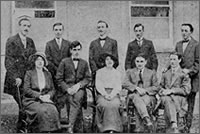
Drama Group c.1910
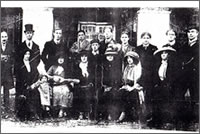
Carrcikford Company c.1920
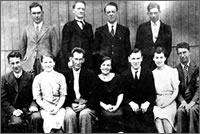
Butt Hall Players 1938
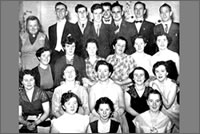
Bachelors Ball 1940s-1960s
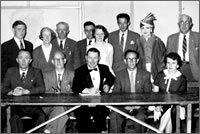
Mick Delahunty & Commitee
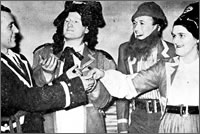
Pirates of Penzance c.1950
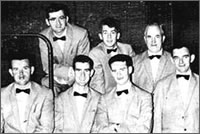
Paddy McCafferty Band c.1950
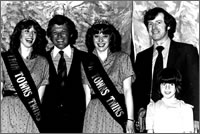
Miss Twin Towns 1970s-1980s
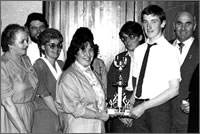
John Paul Youth Club 1980s
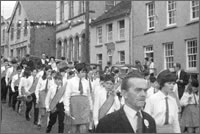
Twin Towns Band
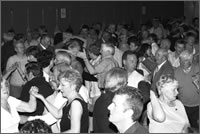
The Last Dance
Photographs
kindly supplied by Pat Holland |




